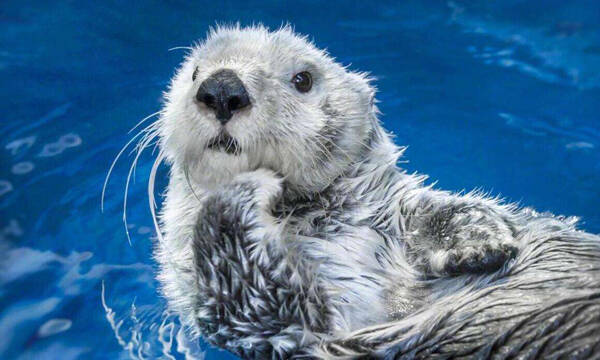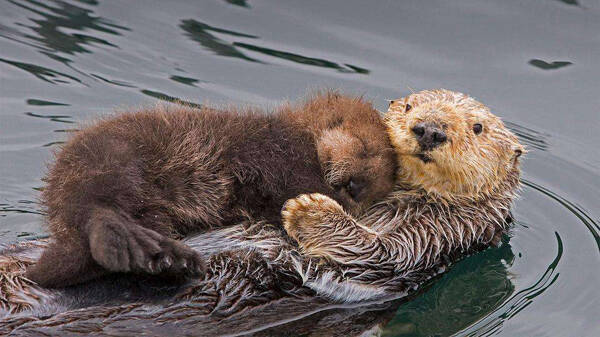Enhydra lutris
IUCN
LCBasic Information
Scientific classification
- name:Enhydra lutris
- Scientific Name:Enhydra lutris,Sea Otter
- Outline:Carnivora
- Family:Spinopoda Mustelidae Lurinae S.Otter
Vital signs
- length:1.4-1.48m
- Weight:32.5-45kg
- lifetime:15-20years
Feature
It has the densest fur in the animal kingdom.
Distribution and Habitat
Distributed in Canada, Japan, Mexico, the Russian Federation, and the United States.
Sea otters inhabit a variety of coastal habitats, ranging from rocky seafloors and shorelines to sandy or muddy seafloors. They usually live in waters less than 40 meters deep, but often move to deeper waters to forage for food or for seasonal migration.
Appearance
The sea otter is the smallest marine mammal. It has a cylindrical body, 1.40-1.48 meters long and weighs 32.5-45 kilograms. The flat tail accounts for about a quarter of its body length. The head is short and wide. The ear shell is small. The snout is short and blunt, the tip of the snout is bare, the upper lip and cheeks are quite developed, and covered with thick hard whiskers. The trunk is fat and round, and the back is thin, resembling a weasel. The forelimbs are short and round, and the sea otter uses them to grab food, groom, and use various tools for cracking shells; the hind limbs are flat and wide, fin-shaped, and webbed; there are webs between the toes. The body is covered with bristles and villi. The tail is long and flat, paddle-shaped. Adult males are thicker in the head and neck than females. There are three subspecies, among which the Alaskan sea otter is larger and thicker than the California sea otter. There are 8 pairs of teeth in the upper and lower jaws.
The teet
Details
Sea Otter (scientific name: Enhydra lutris) is also known as Sea Otter in foreign languages. There are 3 subspecies.

Sea otters are good at diving, often diving to 3-10 meters, and sometimes diving to 50 meters deep to find food. They rarely move on land and never go far from the coast. Compared with other sea mammals, the swimming speed of sea otters is relatively slow, only 10-15 kilometers per hour.
Sea otters like to live in groups. During the day, dozens or even hundreds of them often play and forage in the sea. At night, they sometimes sleep on rocks, but more often they lie on seaweed floating on the sea surface. When there is a big storm on the sea surface, they run to the shore in groups to hide. Unlike other sea mammals, sea otters generally do not make large-scale migrations and prefer to live a settled life. Sea otters are ingenious "engineers". When they go ashore, they will move stones to build beautiful nests. Their tiny "hands" are very good at using tools.
When night falls, some sea otters also climb ashore and sleep on rocks, but most of the time sea otters sleep on the sea surface. They look for places where seaweed grows, roll over and over, wrap the seaweed around their bodies, or grab the seaweed with their limbs, and then sleep with their heads on the waves, so as to avoid the danger of being washed away by the waves or sinking to the bottom of the sea while sleeping. This sleeping mode of sea otters can effectively resist the threat of enemies coming from the shore. When sea otters are sleeping, if they are attacked by enemies or frightened, most members will immediately dive and escape, but a few members often stay to find out the cause of the commotion. Once they find that there is indeed danger, they will use their tails to "crack" the water surface as an alarm signal to notify other members to escape quickly. Sea otters are slow to move after landing, and they detect danger with their sensitive hearing and smell. The sense of smell is very sensitive and can smell the smell of people smoking 8 kilometers away. If someone walks on the beach, they will not go ashore unless the smell left by the person is washed away by several tides. This sensitive sense of smell helps them detect enemies early.

Sea otters usually spend a lot of time combing and licking themselves, including their fur, head, tail, and limbs. They even clean their chest and abdomen, which is their "dining table". This "dressing" is for their own survival. Sea otters rely on their fur for protection. If their fur is unkempt or dirty, seawater will directly penetrate their skin, dissipating the body's heat and freezing them to death.
Most of the food of sea otters is shellfish, abalone, sea urchins, crabs, etc. grown on the seabed. Sometimes they also eat some seaweed and fish. When eating on the water, they often swim on their backs, and sometimes they carry their pups in the same posture. Sea otters are one of the animals with the largest appetite on earth, and usually consume seafood that is one-third of their body weight in a day. Their favorite food is sea urchins, but the shells of sea urchins are very hard and cannot be opened by teeth. Sea otters have come up with a very clever way: after catching sea urchins or other mollusks on the seabed, they first hide the prey in the loose skin bags under their two front limbs, swim to the surface and lie on their backs, put the square stones about the size of fists they carry with them on their chests and abdomens as cutting boards, then use their front limbs to grab the prey and hit it hard against the stones. After a few hits, check whether the shell of the prey is broken. If not, continue to hit it hard until the shell cracks and the meat is exposed. Once the shell is found to be broken, the sea otter will immediately suck out the meat inside. After eating, the sea otter hides the stones and leftover food in the skin bags, so that they will not be lost even if they are hit by waves, so that they can be used again.
During mating, male sea otters become extremely aggressive. The male sea otter will grab the female sea otter and bite her nose hard, usually causing serious injuries, even biting a hole, and sometimes tearing off pieces of the other party's flesh. Only after mating is completed, the male will finally let the female go, and this process sometimes causes female sea otters to be injured or drowned.

Before commercial hunting began in 1741, sea otters were widely distributed, with estimates of their population ranging from 150,000 to 300,000. By 1911, when the United States, Japan, Russia, and the United Kingdom agreed to an international treaty banning the capture of sea otters, the population had been reduced to only a few thousand. Sea otters have recovered well in most areas, but several populations declined between 1990 and 2000 for unknown reasons. The Alaskan population was estimated at about 10,000 in the early 1990s, but declined dramatically in the Aleutian Islands in the mid- to late 1990s. The exact cause is unknown, but some scientists believe it may be the result of predation by killer whales. The California population has also declined, from an estimated 2,377 individuals in 1995 to about 1,700 in 2000. They are listed as "threatened" under the U.S. Endangered Species Act and "depleted" under the Marine Mammal Protection Act of 1977. Their dangers are that they are small populations and are threatened by pollution from fishing nets and oil spills off the central California coast. In the 1980s, there was a plan to repopulate the California sea otter population in southern California, but the sea otters released into the wild after restoration either returned to their original habitat in central California, died due to human factors, or went missing. At the same time, a small natural habitat was established on San Michael Island in the early 1990s, and by the late 1990s, some populations had moved south along the California coast to Cape Conception.
To protect against the cold waters of the North Pacific, sea otters have up to 160,000 hairs per square centimeter.
Listed in the 2015 IUCN Red List of Threatened Species ver 3.1 - Endangered (EN).
The subspecies "California Sea Otter" is listed in the "Washington Convention" CITES Appendix I, and the other two subspecies are listed in the "CITES Appendix II" protected animals.
Protect wild animals and eliminate game.
Maintaining ecological balance is everyone's responsibility!








